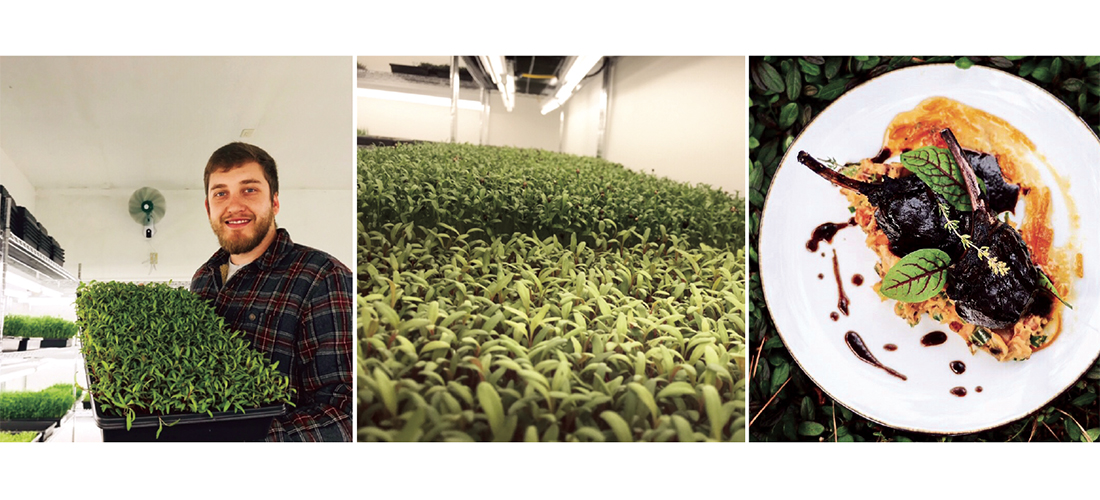
Micro Biz
Delivering nutrition in a tray
By Jan Leitschuh
While the cutting February winds scour the Sandhills, a young Southern Pines entrepreneur putters amid a bright, humid sea of edible green.
His grandfather and great-grandfather were farmers; their tools were mules, harness and hand plows. His tools are scissors and plastic trays, LED lights and stainless steel shelves.
But for Isaac Kundinger, 26, the occupational heritage is identical: growing stuff. His “stuff” is microgreens.
In 2017, Kundinger took his young savings and embarked on the adventure of starting his own business, The Conscious Cultivators LLC. From a building attached to his parents’ house, Kundinger sells boxes of microgreens to area chefs, Nature’s Own Market, the Pinehurst farmers market and elsewhere.
Microgreens are young vegetable greens, approximately 1–3 inches long, grown out from a tray of seeds. The pungent young greens fall somewhere between sprouts and baby leaf vegetables. They have an intense, aromatic flavor and concentrated nutrient content, and come in a variety of colors and textures. The tender greens are full of antioxidants and beneficial phytochemicals.
First introduced to the Californian restaurant scene in the 1980s, microgreens have steadily gained popularity, and can be found in most white-table restaurants these days, either in salads, as a garnish or integrated into various dishes.
Microgreens can be grown from a variety of seeds: lettuces, arugula, kale, sunflower and chards, herbs like chervil and basil, vegetables like broccoli or radish. As such, the rainbow hue of the various sprouted seeds leads some chefs to call it “vegetable confetti.” The rich flavor and concentrated nutrition of microgreens add a welcome splash of color and taste to a variety of soups, salads, eggs and other dishes, say local chefs.
“We use his microgreens in many dishes at the restaurant,” says Matthew Hannon, award-winning chef de cuisine at Ashten’s restaurant in Southern Pines. “It might be a specific herb tailored to a specific dish, or garnish for multiple dishes. We use his greens as salads, blended in soups and sauces, or anything else we can find a use for them. We truly cannot get enough.”
One advantage for Ashten’s, says Hannon, is the hometown connection. “The main thing we like about his product is the quality and freshness,” he says. “His operation is literally blocks from the restaurant so the freshness is unmatched.”
Another local advantage is customization. For Chef Warren’s, for example, Kundinger grows a special mix of fennel, lemon balm and chervil for a specific seafood dish.
Hannon relishes the flexibility. “One thing we like so much is our working relationship,” he says. “Issac is always willing to try new microgreens for us. If there is something obscure we are looking for, he’s willing to give it a whirl. I think it keeps us both excited about new products “
In his operation, Kundinger uses only an organic compost mix in his trays. His lighting is a mixture of LEDs, fluorescents and blue light to ensure maximum health, growth and nutrition. He watches the trays of sprouted seed attentively as they form the first, thin seed leaves. He harvests in a short, carefully timed window, when the majority of the tray develops its first hearty set of true leaves. Fans for air movement ensure the proper humidity, so the greens are not packed wet.
With sterilized scissors and plastic gloves, he carefully snips the tender crops from the seeds in the tray, taking care not to crush fragile cell walls. The microgreens are then packed in special clear containers, weighed, labeled and delivered.
Kitchen gardeners wishing for a little February fresh-vegetable hit could grow ’n’ snip a tray of their own vegetable seeds in a windowsill. The most popular microgreen varieties use seeds from a number of plant families, including:
Brassicaceae: cauliflower, broccoli, kale, cabbage, radish, collards and arugula.
Asteraceae: lettuces, endive, chicory and radicchio.
Apiaceae: dill, carrot, fennel and celery.
Amaryllidaceae: garlic, onion and leek.
Amaranthaceae: amaranth, quinoa, Swiss chard, beet and spinach.
Cucurbitaceae: melon, cucumber and squash.
Pea shoots, curly tendrils and all, are another popular crop for Kundinger. He is experimenting with basil microgreens. Microgreens pack all the nutritional punch of their larger parents, but in concentrated form. According to microgreen aficionados, every salad could benefit.
The road to the microgreen business was convoluted for Kundinger. He’d taken some college classes for pre-dental, but found the work unfulfilling. He had friends out West with a medical marijuana business. “This piqued an interest in indoor farming with me,” he says.
He began researching the science of vertical gardening, making several trips to learn the growing process and techniques. “I began to see, especially in urban areas, that indoor farming is becoming a wave of the future,” he said. “The concept of growing microgreens indoors appealed to me through vertical farming, and it was evident to me that one can grow more nutritious food for more people in much less space. It’s become my passion.”
He started out in a 10×20-foot bay in his parents’ garage and turned it into a vertical grow room with 25 wooden shelves and 20 different varieties of microgreens.
It was a steep learning curve. “There was no manual for me to follow on how to do this,” he says. “I’m learning all this from the ground up.” So to speak.
He experimented with the growing process, the lighting, temperature, airflow and ventilation, heating/air, water, sanitation and more until he developed a thriving environment for microgreens.
“He’s had to learn a lot on his own,” says Eric Wind, Kundinger’s operations manager. “Lots of trial and error.”
Once he was able to consistently produce a top quality product, Kundinger began taking samples to local upscale restaurants, country clubs, health foods stores and farmers markets. “Working closely with the customer is how I have built my clientele over the past two years,” he says.
The walls for his grow room glow white, and the room smells strongly of springtime with a faint undernote of disinfectant. Everything looks clean, bright and fresh. The grow room walls are a special washable material, glossy and easy to sanitize. He uses fans for airflow, to prevent mildew. Watering routines are strict. The racks are stainless steel, replacing his original wooden racks — stainless steel the preferred surface for sterilization.
An eye on larger markets has prompted many of these changes. While the business is successful, Kundinger sometimes must work part-time to fund expansion and sanitation upgrades and boost his income.
To ensure a self-supporting business, he knows he has to grow his markets. “My vision for the future is to get GAP-certified (Good Agricultural Practices, a USDA audit program) so that I can expand to large distributors, catering companies, colleges and other large commercial outlets,” he says. He recently tripled his indoor vertical space.
Building a business from the ground up has not been easy, but there have been rich, unexpected gifts. “Figuring this business out taught me discipline,” he says. “I just want this so bad.”
Another gift has been the ability to live his values. The name of his business, The Conscious Cultivators, suggests as much. “It reflects my passion for natural farm practices, and to highlight my core values,” he says.
“I can truly say that I am finding joy in the journey. I am deeply thankful to all of the chefs and businesses that have supported me and believed in me — they played a huge role in my success. Seeing my product used so creatively and artistically to create mouthwatering and nutritious dishes in our local restaurants — and knowing that I played a part in it — has been extremely rewarding.”
As for the chefs, they are effusive in their praise.
“We’ve always known Issac was on to bigger and better things,” says Hannon. “His commitment to his craft definitely shines in the end result.” PS
Jan Leitschuh is a local gardener, avid eater of fresh produce and co-founder of the Sandhills Farm to Table cooperative.





